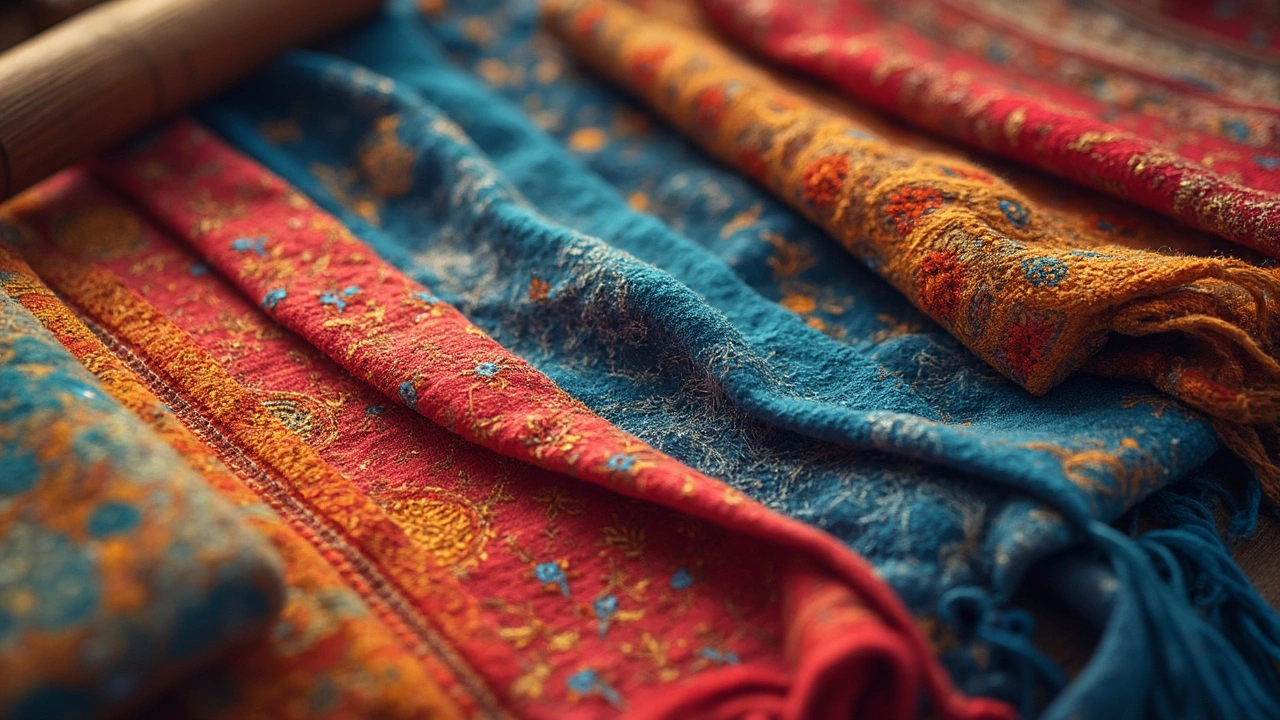So, you're thinking about getting yourself a suit, but you're stuck. Is the high price tag really worth it? Or can a cheaper option do the trick? Well, the devil's in the details, my friend.
First up, let's talk fabric. Expensive suits usually boast top-notch, natural fabrics like wool, silk, or cashmere. Feel them, and you'll notice a softness and a drape that screams quality. Cheaper suits might look shiny because they're often made from synthetic blends like polyester. The touch can feel coarse and, well, cheap.
Next, we move to construction. Consider the jacket's interlining. In pricy suits, it's usually a floating canvas, making it drape better on the body. On the other end, cheaper suits use glue to stick the layers, which might bubble and wear out fast.
The Fabric Factor
Alright, let's get into the nitty-gritty of fabrics. This is a huge marker of whether you're dealing with a cheap or expensive suit. High-end suits often feature fabrics like wool, silk, or cashmere. Why? Because these are natural fibers that breathe well and, over time, mold beautifully to your body shape. Imagine a glove that fits perfectly—the same idea but for your frame.
On the flip side, cheap suits might look similar at a distance but get closer, and you'll notice a difference. Ever seen a suit that shines like it's been laminated? That's likely polyester or a synthetic blend. It's durable, sure, but it doesn't have that same luxurious feel or movement.
Let's throw some numbers to chew on. A study of suit fabrics found that premium wools range between 100 to 250 grams per square meter in weight, giving that lightweight, breathable feel. Compare that to lower-end polyesters, which often weigh more and trap heat. Not great if you're planning to wear your suit beyond the winter months!
Spot-checking these fabrics is crucial. When you're in a store, give the sleeve a gentle scrunch and let go. Does it spring back with ease or does it just stay wrinkled? Natural fibers usually resist wrinkles better—that’s a plus for both appearances and practical wear.
Even blends can be telling. A mix of wool with some synthetic might lower the cost but keep some quality. Just make sure it doesn't skimp too much on the natural elements. Always check the label and, if in doubt, feel it out! Your hands will tell you if it's worth the investment.
Construction Matters
All right, let's get down to the nitty-gritty of how a suit is put together. It's more than just stitching a bunch of fabrics and calling it a day. The way a suit is constructed plays a big role in its durability and comfort.
First thing to check is the suit's canvas. In higher-end suits, you'll find a full canvas or half canvas. This is the layer inside the jacket that gives it structure, helping it mold to your body over time. That's why a full canvas expensive suit tends to fit better the more you wear it. It's sewn in, not glued. Cheaper suits, on the other hand, often use what's called a fused canvas. This one's glued, which doesn't allow for the same movement and can lead to bubbling after a few dry cleans.
Shoulder pads are another thing. Men's suits with a natural shoulder construction are often a sign of a more valuable suit. It lets the fabric fall naturally and look seamless on your body. Cheaper versions might use bulky, sharp-edged shoulder pads that can look awkward and outdated.
Oh, and don't forget the stitching. On a quality jacket, the stitches should be tight and even. Flip a good suit inside out and you'll notice the clean seams and perfectly aligned lining. Cheaper suits might have loose threads and mismatched patterns at the joints, which can unravel quickly.
Last but not least, check out the lining. Expensive suits usually come with breathable lining like Bemberg or silk. It helps keep you cool and feels great against your skin. Synthetics in cheaper suits might make you feel like you're wearing a sauna.
Here's a quick table to sum up some differences:
| Component | Cheap Suit | Expensive Suit |
|---|---|---|
| Canvas | Fused | Full or Half Canvas |
| Shoulder Pads | Bulky | Natural |
| Stitching | Loose | Tight |
| Lining | Synthetic | Bemberg/Silk |
Understanding these construction elements can help make sure you're getting the best value, whether you're hunting for cheap vs expensive suits or just curious about the craftsmanship behind a good suit.

Fit and Finish
When you're wearing a suit, fit is everything. A men's suit that fits like a glove can boost your confidence, while one that hangs awkwardly will only bring you down. The truth is, even the priciest suit can look lackluster if it doesn't fit right.
Let's break it down. Check the shoulders first. The seams should sit where your shoulder ends, not drooping down your arm. This is a telltale sign of a quality suit—especially if it's made to measure. Off-the-rack suits, on the other hand, might require some tailoring to get that perfect fit.
Now, onto the jacket length. Aim for the hem of the jacket to cover your backside. This isn't just about style; it's about balance. If it's too long or too short, it throws off your proportions.
- Sleeves: They should end just above the wrist bone, showing a half-inch of your shirt cuff.
- Trousers: Go for a slight break, where the pants gently touch your shoes. Avoid puddling fabric at your ankles—that's a no-go.
The finish of a suit is just as crucial. Look for neat stitching and clean lines. The buttonholes on more expensive suits are often hand-stitched, showcasing fine craftsmanship. Also, the buttons themselves are worth a glance. Are they cheap plastic, or are they made from horn or mother of pearl?
A quick peek inside can reveal a lot too. High-quality suits have a full lining or a partial one with a clean finish. If you see loose threads or a flimsy look inside, you might be dealing with a cheaper option.
Details That Speak Volumes
Alright, let's get into the nitty-gritty. When you’re eyeing a suit, the little things can make a big difference in spotting a cheap men's suit versus an expensive one. Every stitch, button, and seam tells a story.
First, take a peek at the buttonholes. In more expensive suits, these are usually hand-stitched, which gives them a slight irregularity—kind of like a signature of quality craftsmanship. They aren’t just functional; they’re decorative too. Cheaper suits might have machine-stitched buttonholes that look too perfect and, let's be honest, a bit bland.
Now, buttons themselves. On higher-end suits, you’ll find buttons made from horn, mother of pearl, or corozo, giving that nice subtle sheen. Cheaper options? You’re probably looking at plastic, which can look flat and even sometimes wears down quickly.
Another neat trick to spot quality is the lining. Good suits have Bemberg or silk linings, allowing the jacket to glide over your shirt like a dream. Cheaper suits cut costs with polyester, which can stick and even make you sweat more. That’s no fun at a summer wedding!
If you can, flip the suit jacket inside out. Inspect the stitching. A suit with delicate, consistent stitches along the lining is a sign of care and time invested in its making. In contrast, a low-quality suit might have loose threads or uneven stitching.
Lastly, don't overlook the lapels. Higher-end suits will have hand-stitched lapel edges that roll and give the suit a soft, tailored appearance. Cheap suits often have a more rigid, flat lapel due to machine pressing.

Price vs. Value
Alright, so when we think about price vs. value in suits, it’s easy to get caught up in the numbers game. A high price doesn't always guarantee the best quality. Sometimes you're just paying for a name. But how do you know if you're really getting good value for what you spend?
First, consider the fabric. Expensive suits crafted from wool or cashmere tend to last much longer than those made with synthetic blends. Over time, the initial higher cost can save you money if you're not replacing your suit every couple of years.
Next, think about the fit. A good suit should feel like a second skin. It needs minimal alterations, and the fit stays true even after multiple wears. An excellent fit can make a moderately priced suit look pretty high-end.
Then there’s maintenance. High-quality suits often require dry cleaning or careful at-home cleaning methods, while cheaper materials may be washed at home but won't hold up as well. Factoring in these ongoing costs is key to understanding real value.
Another thing is details and craftsmanship. The quality of stitching, buttons, and even the lining will tell you a lot about whether a suit is worth its price. Handmade suits, for example, often boast better longevity thanks to superior craftsmanship.
To break it down, if you’re paying more, you’re generally investing in better quality material, a refined fit, and meticulous details. However, there's still a sweet spot where you can find a great balance—offerings where mid-range priced suits pack impressive quality similar to high-end options.
